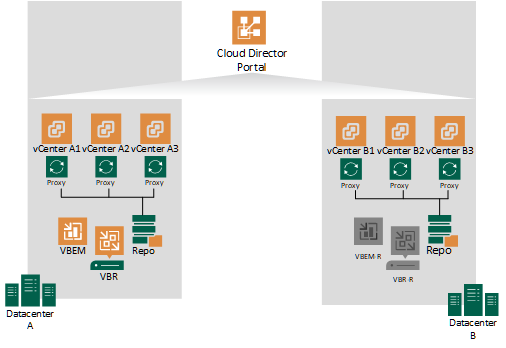Veeam Service Providers Best Practice Site
Frontend Scalability
Providing data protection as a service in a multi-tenant environment comprises of:
- Backend solution: Veeam Backup and Replication (VBR)
- Frontend solution: Veeam Backup Enterprise Manager (VBEM)
A common question during the initial design process is the number of VBEM servers and their relationship with VBR servers. In this section we will clarify it.
In a standard deployment, backup infrastructure is fully configured using VBR. However, management of a tenant’s backup jobs and restores can be done from the Self-service Portal, which is part of VBEM:
- Self-service portal for VMware vSphere.
- Self-service portal for VMware Cloud Director.
- Self-restore portal for other platforms (https://helpcenter.veeam.com/docs/backup/em/em_self_restore.html).
Placement and segregation
-
One VBEM can connect to multiple VBR servers. It is recommended to install the same product version on each VBEM server and VBR server, however backward compatibility is available.
-
Multi-site vCenter or multi-site VCD.
In this deployment scenario, it is recommended to deploy one VBEM per site. This increases resiliency of the overall service. An outage in site A will not impact site B, thus the Self-service Portal will still be available in site B.
-
When multiple VBR servers are connected to the same VBEM, only one VBR can be responsible for a VCD organization. Connecting the same VCD organizations to different VBR servers that connect to the same VBEM is not supported.
Due to the fact, in the streched Cloud Director design (Cloud Director with multiple vCenters located on different sites) it’s recommended to have single VBR and EM deployment for the entire Cloud Director.
To avoid single point of failure those instances have to be replicated between sites



